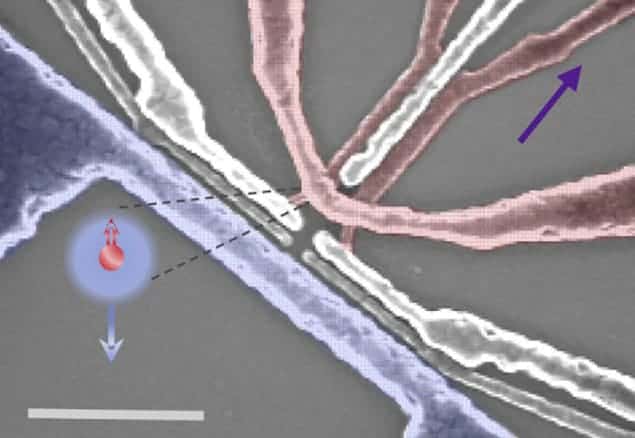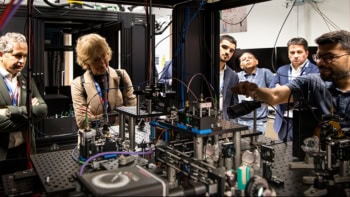
Quantum information has been stored in a single atom of phosphorus embedded in a silicon crystal – and then retrieved at a later time. The quantum memory was made by physicists in Australia who say that this kind of memory could be an important ingredient in silicon-based quantum computers with the potential to be more scalable, compact and easier to mass-produce than devices based on rival technologies.
Long-term storage in classical computers is straightforward; digital bits are simply copied from the processor to a rotating magnetic disk or other suitable medium. But quantum computers, which encode data in the form of quantum bits, or qubits, face a fundamental obstacle – the no-cloning theorem dictates that it is impossible to copy the state of a qubit or any other quantum object.
A quantum memory instead involves transferring a quantum state from one qubit to another, so erasing the state of the first qubit in the process. Because the second qubit – the “memory qubit” – is chosen to be more resilient to external sources of electrical or magnetic interference that would otherwise destroy quantum coherence, this transfer could enable computations that rely on information being parked temporarily while other data are processed. However, the first qubit – the “processing qubit” – also plays its part. Being less resilient to interference, it is therefore also more responsive to deliberate electromagnetic stimulation, and as such is used to read and write data.
Extra electron
In the latest work, Andrea Morello of the University of New South Wales and colleagues have exploited a natural two-qubit system by doping silicon with atoms of phosphorous. Silicon atoms contain four electrons in their outer shells. This means that each electron forms a covalent bond with a neighbouring atom and this gives silicon its crystal structure. Phosphorus, which is next to silicon in the periodic table, adds an extra positive charge to the lattice, so attracting an extra electron. This effectively creates a hydrogen atom in which the less magnetically sensitive nuclear spin forms the memory qubit, while the electron spin acts as the processing qubit.
Silicon’s crystal properties means that an electron confined in its lattice has a very narrow spatial wavefunction – being just a few nanometres wide. As Morello points out, this means having to manipulate a solid-state circuit at close to the atomic scale, something, he says, that “is not a cup of tea in a university research lab”. But silicon’s long quantum-coherence times gives it a major advantage over rival technologies – as does the ease at which silicon devices can be manufactured. This is because its spins are naturally insensitive to electric noise and can be made very insensitive to magnetic noise by enriching silicon so that its only isotope with nonzero nuclear spin – silicon-29 – is almost entirely absent.
In their experiment, Morello and colleagues implanted phosphorus atoms into a 100 × 100 nm2 region of a 900 nm-thick layer of enriched silicon. They set the initial state of the phosphorus electron spin using a microwave antenna fabricated on top of the silicon chip. That spin state is then transferred to and from the nucleus using a series of radio-frequency pulses from the same antenna. To read out the value of the electron spin, they created a single electron transistor from aluminium electrodes fabricated on the chip. The transistor is turned on if the electron escapes the phosphorus nucleus, which only happens when it is in its (high-energy) spin-up state.
Remarkably long time
The researchers found they could transfer the spin state of the phosphorus electron to the nucleus and keep it there for up to 80 ms – “a remarkably long time in the solid state,” says Morello – before transferring it back to the electron and reading it out. Unfortunately, they found that the electron’s final state only matched its initial state around 80% of the time – a fidelity that fell far short of the 99% possible when operating the electron and nuclear qubits separately. They believe this is caused by a shift in the electron’s resonance frequency after they turn on the radio-frequency pulses, and say that they will now work to eliminate this shift.
Morello’s group is not the first to demonstrate quantum memory in silicon. Back in 2008, John Morton, then at Oxford University, and colleagues did so by collectively manipulating the spin states of billions of phosphorus atoms in a large piece of silicon crystal. But Morton says the latest work is important because in a large-scale quantum computer, information must be encoded into individual qubits. He notes that the hardest part of the experiment was reading out the electron spin state, the Australian group having first developed its detection technique in 2010.
Morton, now at University College London, concedes it “remains an open question” among physicists about how useful this kind of memory would be, given doubts about the length of time that electrons would be “idle” as opposed to processing, and also given the need for very high fidelities. One “very exciting” future avenue of research, he says, is to use nuclear spins that are more weakly coupled to the electron spin, such as the spin-1/2 nuclei of silicon-29 in naturally occurring silicon. Being less affected by the electron’s removal during the read-out process, they could potentially operate with fewer interruptions than the phosphorus nuclei.
The research is reported in Quantum Science and Technology.
- In this video, Andrea Morello answers the question “Why use silicon qubits for quantum computing?“.



